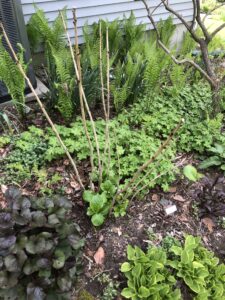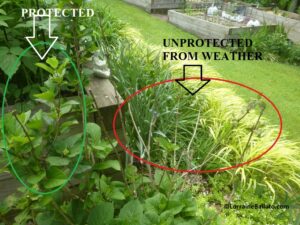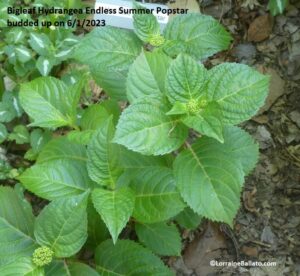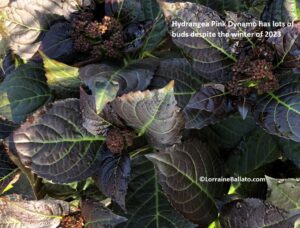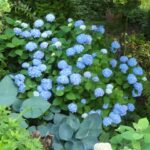Big leaf hydrangeas (macrophyllas) had a hard time this past winter in the northeast U.S. and elsewhere. The big question is: will your big leaf hydrangeas bloom this summer before the first frost of autumn knocks them back?
WHAT HAPPENED THIS PAST WINTER
Let’s step back and understand what happened. Yes, we had a relatively mild winter with record breaking warm temps. There were unprecedented daytime highs in December, the warmest January on record in Connecticut (where I grow my plants), and would you believe 67 degrees in February, another record breaking warm month? But alas, we also had devastating low temperatures. Worse yet, there were swings from a daytime temperature of 59 degrees to 8 degrees that same night in December. And those night time freezing temps stayed there for several consecutive days. To add insult to injury, just when we thought the worst of the weather had passed, we had a freeze on the night of May 18, the latest date for spring freezing temperatures in Connecticut. If your flower buds weren’t gone by then, they surely got zapped in May.
WHICH HYDRANGEAS ARE AFFECTED
None of the weather issues are a problem for panicle hydrangeas like ‘Limelight’ or woodland hydrangeas like ‘Annabelle’. They flower on new growth in the current season. Old wood climbing and oak leaf hydrangeas are also pretty tolerant of these weather challenges. Not so for the stem-sensitive big leaf and even mountain (serrata) hydrangeas. Although they are rated hardy down to zone 4 in some cases that means the ROOTS will make it. Stem hardiness – where the flower buds live – is quite another issue.
THE EFFECT OF TEMPERATURE SWINGS
Temperatures are the big driver for what plants do. They break dormancy and leaf out in spring when average daily temperatures begin to steadily rise. They do just the opposite as the season draws to a close and go back to sleep with falling temperatures later on.
January was the warmest on record in Connecticut and many other places, sending the plants mixed signals. If that wasn’t bad enough, we had two very frigid nights in early February where temperatures went below zero for 2 consecutive nights. That sudden extreme cold on the heels of a warm January put big leaf and some mountain hydrangeas to the test. Could their buds survive such extreme/variable conditions?
Now we know the answer to that question. The answer is Yes and No. You can see it in your own plants. Some have new growth coming from the base and brown sticks protruding above that growth.
Others have no signs of life, either at the top or the bottom. And a few are actually unaffected by the winter weather. What made the difference?
HOW TO FIX THE PROBLEM OF A NON-BLOOMING HYDRANGEA
Plants that were unaffected by weather were planted in the protection of winter persistent foliage or structures. Azaleas, rhododendrons, a fence, and conifers kept this mountain hydrangea protected. You can see it is loaded with buds.
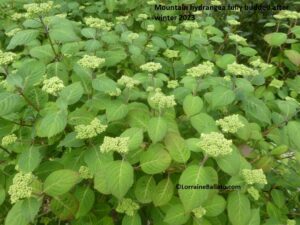
Mountain hydrangea fully budded after winter 2023
Across the garden, another mountain hydrangea was half protected by a raised veggie bed. On the exposed right side, the buds got killed vs. the left side which survived just fine thanks to the timbers of the veggie bed.
The lesson is you can improve your odds of getting flowers in future seasons by making some changes. The first is to move your plant so it is protected from prevailing winter weather by winter persistent something: maybe a conifer, rhododendron, or azalea. Maybe even a structure like a neighbor’s house, a fence, or a shed. If moving it isn’t an option, how about planting something close to it that grows quickly to provide that protection? Just be careful of root competition that “protector” will demand over time.
WHAT TO DO NOW IF YOU HAVE A REBLOOMING HYDRANGEA
If you have a reblooming hydrangea like Endless Summer®, you have a chance of seeing flowers before the season ends. Give it a little love: fertilize it properly and make sure it doesn’t lack for the right amount of water this season.
But don’t expect too much on the first bloom cycle in June. It all depends on where you have sited your plant. Any plant that was exposed to the winter weather without protection will be in sad shape with lots of stem die back. Cut them back which will stimulate new growth, and be sure to fertilize them.
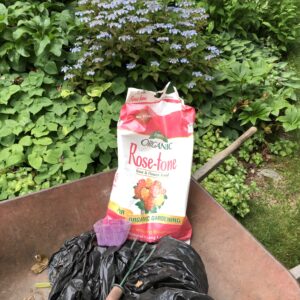
Fertilizing hydrangeas early summer
WHAT TO DO IF YOUR HYDANGEA IS NOT A REBLOOMER
If your plant is not a rebloomer, you can pretty much count on having a nice green bush with no flowers. Maybe it’s time to trade up. Replace with rebloomers which have the genetics to push up new growth from the base and deliver a flower without needing a cold set period (like fall or winter).
Endless Summer® and Let’s Dance® have several options in those series that might work well for you. Some are even compact so you don’t need a huge space for them. The newest Endless Summer® is Pop Star® and is especially impressive. All of my sample plants have buds. Other dependable rebloomers like Blue Enchantress® are also good choices.
You can also replace any dead or half-dead plants with mountain (serrata) hydrangeas. They are much more tolerant of winter weather conditions owing to their origin in the mountains of Japan. Plus most of them have a lacecap flower which is a veritable feast for pollinators. The rebloomers like Hydrangea Serrata Tuff Stuff™ and Pink Dynamo™ are superb garden choices. Frankly, just about any mountain hydrangea will be a better choice. Most of mine are fully budded up and ready to deliver.
The time for tears and anguish is over. Just get to it so you can save your season.
UPCOMING PUBLIC SPEAKING DATE

Speaker delivering presentation
I am delighted to tell you that I will be giving a hydrangea talk at White Flower Farm on Saturday, June 24. We’ll be outside for an informative discussion and demonstration on caring for a wide variety of hydrangeas. Fee of $15 includes $5.00 off any Hydrangea purchase. Registration required. Come/bring your friends. I’d love to meet you.
OTHER GOOD NEWS
My hydrangea book, Success With Hydrangeas, has been selling well, despite it being out for 5 years. If you have the time, an on-line review will keep it front and center on search engines.
And finally, congratulate yourself! You are the subscribers/readers of an award-winning blog. It is in the running for the top prize for a garden-related blog. This recognition comes from GardenComm International, an association of garden communicators (writers, photographers, authors, podcasters, etc.). I won’t know until August whether I will be taking home the grand prize but it is more than enough to know that my work on this blog has been publicly recognized.
Thanks for reading.
6 Secrets for Stunning Hydrangea Flowers
Get my FREE mini-guide with 6 fool-proof tips showing how to grow hydrangeas that produce the most amazing flowers.
No spam - I promise!
